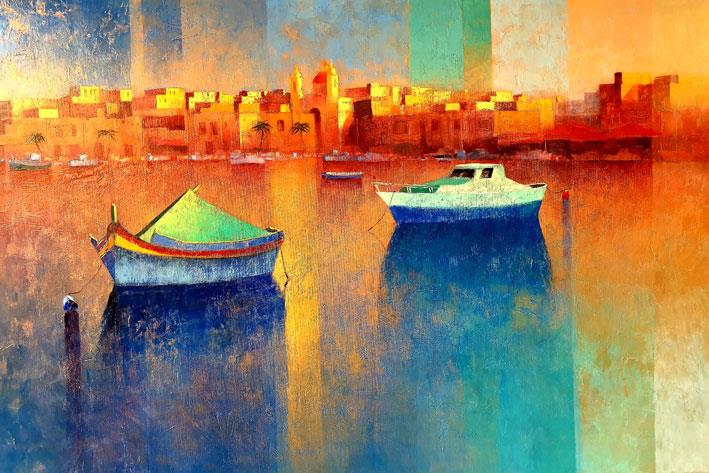The landscape reflects the soul's yearning, merging the outer world with the inner self in an eternal dialogue - John O'Donohue, 2000
British cultural historian and professor of cultural studies and art therapy, Susan Hogan, stated in Art Therapy Theories: A Critical Introduction (2016), "colours and forms in artwork can act as symbols of an individual's inner world". These words resonate with Christopher Saliba's paintings, which reflect his deep connection to the Maltese landscapes and seascapes he portrays. Through his expressive use of colour and texture, Saliba's artworks serve as a window into his emotional and spiritual engagement with the Maltese environment.
Saliba's paintings reveal his distinctive approach to Maltese settings. Using vibrant hues -fiery reds, intense oranges, deep blues and rich indigos - he animates iconic Maltese skylines, horizons, traditional buildings and boats. His technique, leaning towards abstraction, incorporates textured surfaces that suggest reflections on water and land, enhancing the viewer's immersion in a Mediterranean scene.

Birgu
Stylistically, Saliba's work embraces a primitivising aesthetic, where simplified forms and a bold palette create a spiritual dialogue with the self. A compelling approach fosters a meditative connection with the scenes, inviting viewers to reflect on the spiritual and historical significance of Malta's landscapes. This blend of vibrant colours and gentle textures creates an atmosphere that is both powerful and calming, immersing viewers in an experience shaped by the beauty of nature and the richness of cultural heritage. These quasi-abstracted landscapes are still recognisable Maltese symbols which evoke an impact on both an aesthetic and emotional level. The psychological depth of Saliba's art can be further understood through concepts in colour psychology, abstraction and symbolism.
Swiss psychiatrist Carl Jung (1964) proposed that "colour is the mother tongue of the subconscious" (Man and His Symbols, 1964). In Saliba's work, the rich reds, oranges and blues become channels for subconscious expression. These hues, vibrate with vitality, passion and spirituality, connect viewers to universal emotions, inviting a dialogue with their inner landscapes.

Marsalforn by Night
In Skylines, Saliba captures familiar Maltese landscapes that celebrate the nation's identity as a Mediterranean island bathed in bright light and colour. In Marsaxlokk, warm oranges and deep blues convey the glow of a fishing village, with sunlight spilling over the harbour. Layered brushstrokes lend the water a profound, dreamlike quality, uniting land, and sea through a peaceful horizon. Marsamxett, meanwhile, presents a vibrant urban scene in bold reds and purples, evoking the density of city life. Here, the horizon is solid and grounding, emphasising the energy within the landscape, as textured colours capture the harbour's warmth and vitality. In contrast, Marsalforn by night employs cooler blues and deep tones to capture the stillness of dusk. The softened, blurred skyline imparts a surreal, mystical atmosphere, with the horizon melting into the sky, expressing a peaceful nighttime.

Marsamxett
The Three Cities have long inspired both local and foreign artists. In this collection, Saliba captures the city of Birgu as viewed from across the water, specifically from Senglea. Despite being rendered within a thick, misty atmosphere, characterised by vertical bands of dark yet smooth, warm colours, the buildings near St Lawrence parish church remain recognisable. The old British bakery, Caraffa Stores and the Admiral's House - now housing several restaurants along the yacht marina - still retain the architectural elegance of Birgu, the first capital city of the Knights of St John. In this maritime scene, Saliba included a collection of traditional Maltese boats floating on still water, with their reflections stretching downwards in elongated, textured strokes. The boats are painted in shades of deep green and blue, contrasting vividly against the backdrop of rich oranges, golds and reds that suggest a striking sunrise or sunset. The layered hues create a dreamlike quality, with the horizon softly blending into the sky.

Marsaxlokk
American existential psychologist Rollo May offers another perspective which one can adapt to Saliba's work. In The Courage to Create (1975), May observed, "art enables us to find ourselves and lose ourselves at the same time". Saliba's use of abstraction and minimal detail fosters a reflective, thoughtful experience. By focusing on colour and form, he guides viewers into a meditative state, where familiar Maltese landscapes become a space for self-exploration, aligning with May's belief that art facilitates encounters with the unknown within us.
Viewed through a psychological perspective, Saliba's art becomes a form of "soul work", where colour, abstraction and symbolism create pathways to the subconscious. The intense colours, simplified forms and familiar Maltese symbols encourage viewers to reflect on their inner worlds and their connection to places and culture. Saliba's portrayal of Malta resonates as a visual expression of memory, identity and emotion, making his paintings not merely depictions of place but mirrors of the viewer's inner experiences and spiritual yearnings.
In this exhibition, the skyline transcends its role as a simple meeting of land, sea and sky to become a powerful expression of sentiments that unites each scene. These contemporary expressionist landscapes by Saliba, infused with strong elements of abstraction, pulse with life. The skyline is charged with energy and emotion, seamlessly merging the viewer's inner world with the depicted scenery.
The exhibition is being held at Art..e Gallery, 1, Triq il Librerija, Victoria, Gozo.
Viewing hours: Mondays to Saturdays: 9.30 am-12.15 pm; Sundays: 10am to 12noon.
The exhibition will run until Saturday, 28 December.
Professor Louis Laganà PhD (Lough) is an academic, art historian and practicing artist